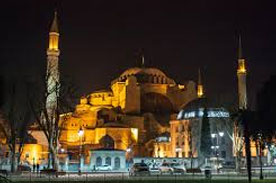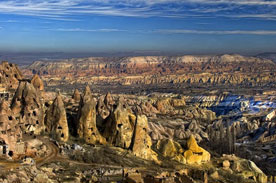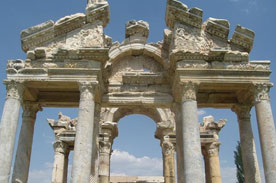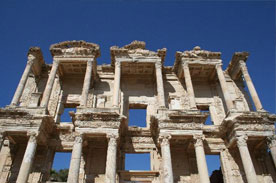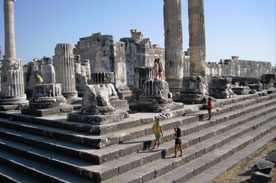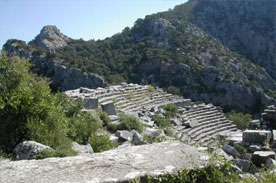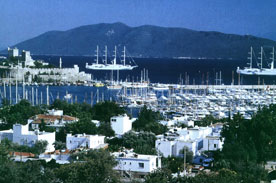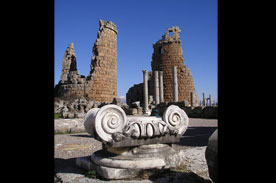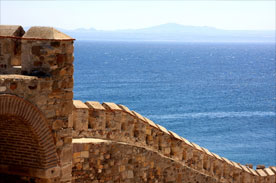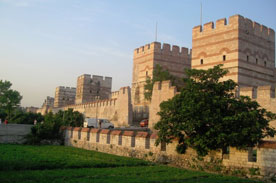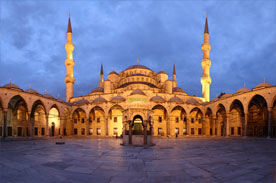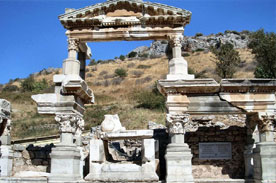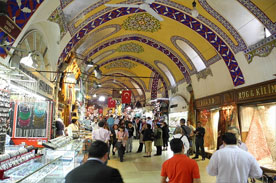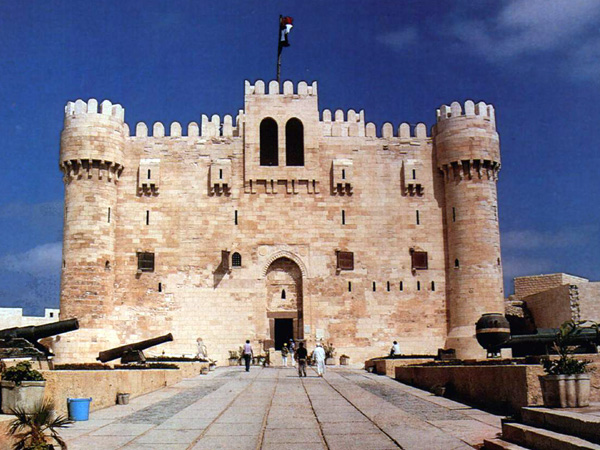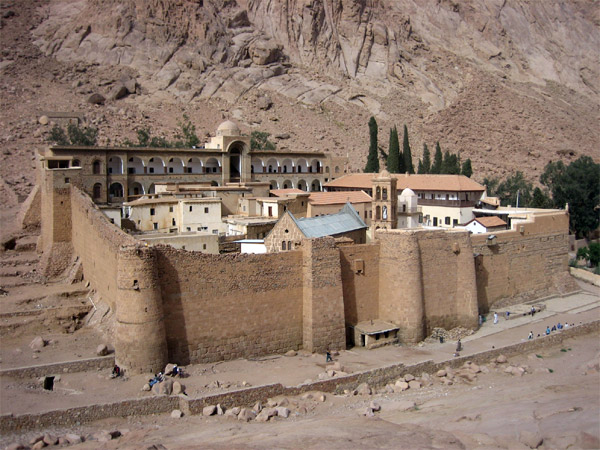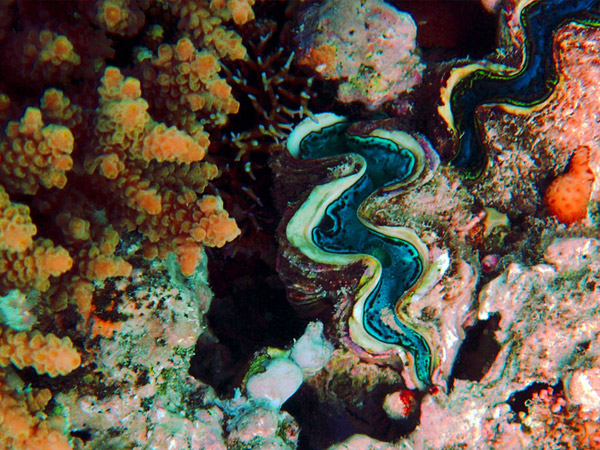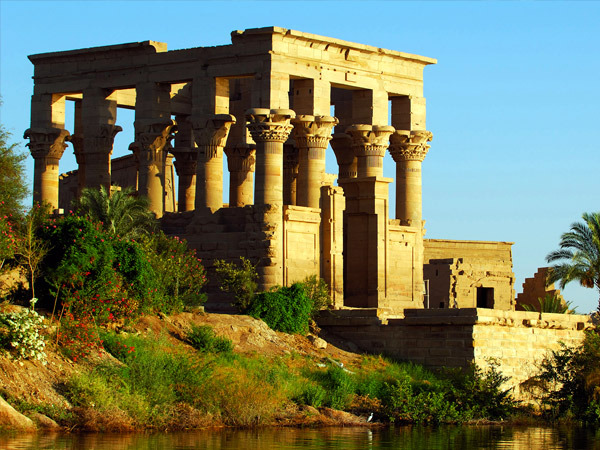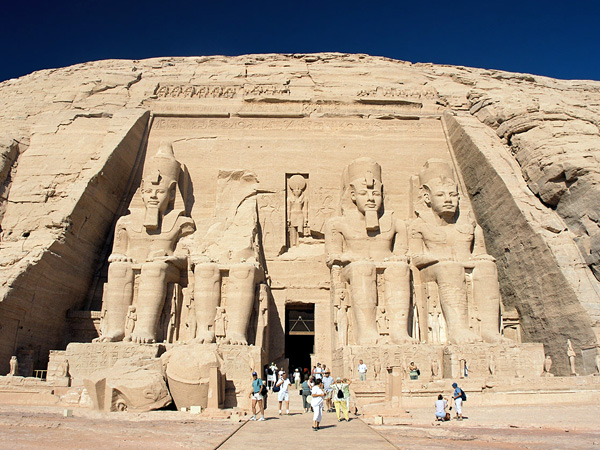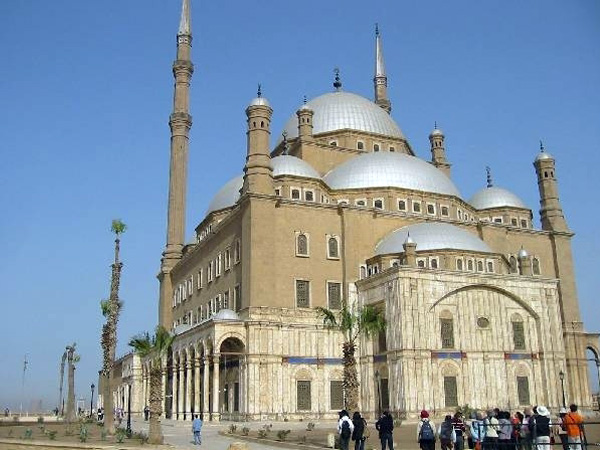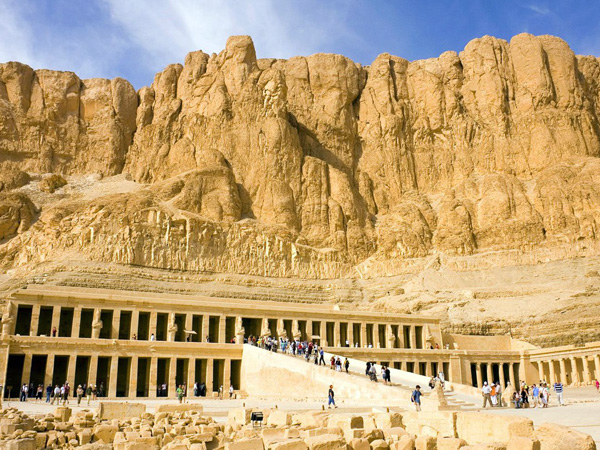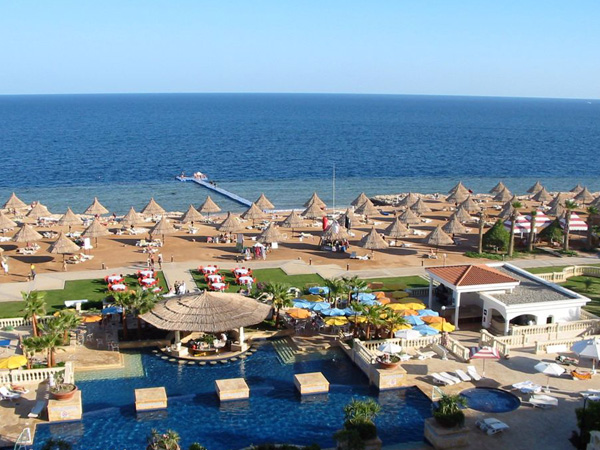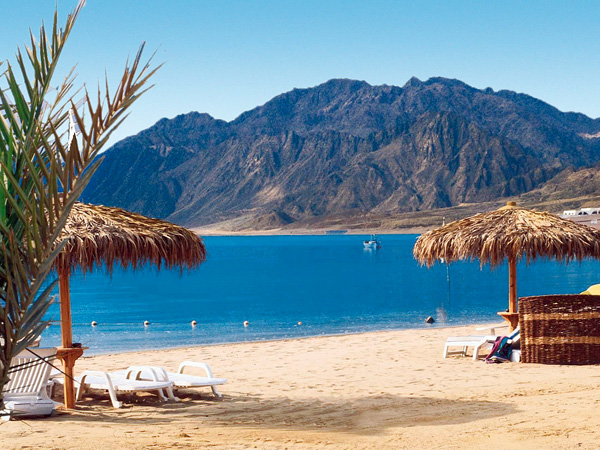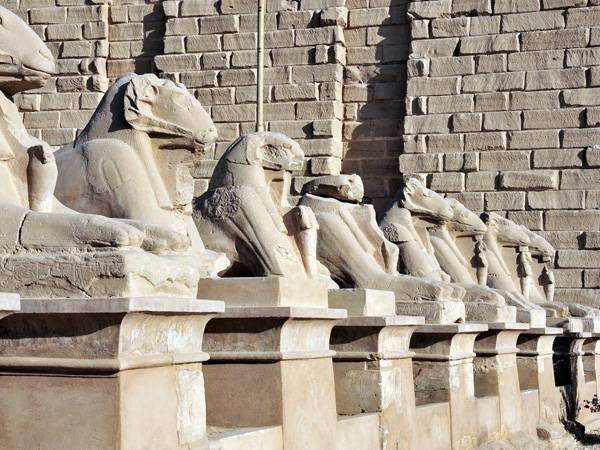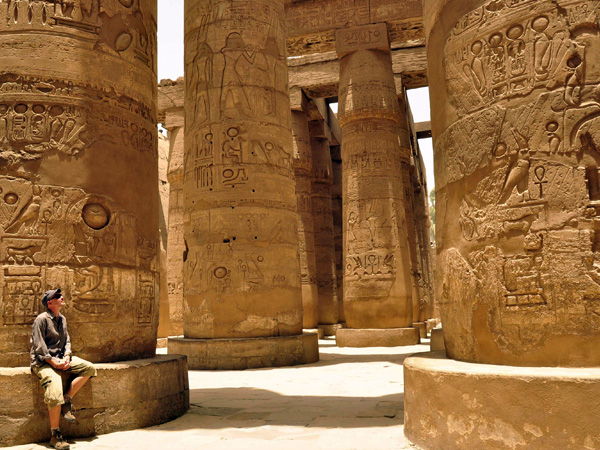Turkey-On the Trail of the Great Goddess
Price starting from
$3395Per Person
Prices are quoted in US Dollars per person per trip.
Trip Duration :
16 Days / 15 Nights
Related Packages
TURKEY-On the Trail of the Great Goddess May 23-June 7, 2015
About the Tour Directors -


Rev. Dr. Karen Tate has traveled to Turkey several times leading tours. She’s the author of Sacred Places of Goddess: 108 Destination, Walking An Ancient Path: Rebirthing Goddess on Planet Earth, Goddess Calling: Inspirational Messages & Meditations of Sacred Feminine Liberation Thealogy and Voices of the Sacred Feminine: Conversations to ReShape Our World. She is an independent scholar, radio show host, social justice activist and Adepta within the Fellowship of Isis. Karen can be seen in the documentary Femme: Women Healing the World. and will be teaching herstory along the journey and doing ritual for those interested in participating. For more information go to www.karentate.com
Some words from Rev. Tate: Turkey is a diamond in the rough, a melting pot of cultures, replete with sacred sites devoted to the Feminine Face of God, including Mary, Aphrodite, Isis, Kubaba, Hecate, Athena, Hera., Demeter. Cybele, Artemis and many more. The trip will be a once in a lifetime experience, delighting history buffs and Goddess advocates alike as we tickle your exoteric and esoteric psyches. Enjoy the delicious foods of the region, doing ritual at Her sacred sites and of course there's “sacred shopping” as your dollar spends better in Turkey, not yet converted over to the Euro.


Dr. James Rietveld, received his PhD in History, Religion, & Archaeology from Claremont University and currently teaches at California State University Fullerton. Rietveld is an authority in Greco-Roman Religions, History of Christianity, Islam, and Hinduism, having a passion for studies surrounding Asia Minor (what is “Turkey” today) and, especially the city of Ephesus, the focus of his upcoming book: Artemis of Ephesus: Mystery, Magic, and Sacred Landscapes, due out the Fall of 2014. Rietveld has written over 30 articles and one book (Apocalypse of 1666), hosts his own radio show, Myth & Legend, History & Religion, and is a known public speaker who will lend his expertise on religion and history as we journey through Turkey.
Detailed Itinerary-
Day 1: Saturday, May 23. Arrive Istanbul (D)
Arrive on your own in Istanbul. Turkish Airlines has two departures from New York City’s JFK Airport on Friday, May 22nd, arriving in Istanbul on Saturday, May 23rd. (Once you have registered for the trip Nabila Tours & Cruises will be happy to assist you to book one of these flights.)
Clear immigration, claim your luggage and exit through customs. Nabila Tours local travel representative will meet the group(s) in the Arrival Hall. Transfer to the hotel. (Details to be provided in the final itinerary to be sent to the group 2 weeks to 10 days before the tour begins.) Or if you do not arrive on one of the two Turkish Airlines flights, Nabila Tours can arrange a private transfer for you after you register; price is additional to the tour package pricing.
Check in at the hotel. Time for rest and relaxation.
Welcome dinner at the hotel. Overnight Istanbul.
Day 2: Sunday, May 24. Istanbul: Hippodrome, Hagia Sofia, Gasilica Cistern; Free Time (B/D)
This is a day to explore the ancient heart of the old city Constantinople. Sites you will visit are: 1) The Hippodrome, a circus that was the sporting and social center of ancient Constantinople, capital of the Byzantine Empire. Today it's a square named Sultanahmet Meydanı (Sultan Ahmet Square), with a few fragments of the original structure surviving. The word hippodrome comes from the Greek hippos (horse) and dromos (path or way). Horse racing and chariot racing were popular pastimes in the ancient world and hippodromes were common features of Greek cities in the Hellenistic, Roman and Byzantine eras.
2) The Blue Mosque with its mighty dome is the only mosque in Istanbul with minarets. It was built on the site of the Great Palace of Byzantium, in the early 17th century. Today it’s still a working mosque and is therefore closed to non-worshippers during the five daily prayers. The interior, with its beautiful blue tiles, lightness, spatial effect and color, is one of the finest creations of Turkish architecture.
3) The St. Sophia Museum, built by Constantine the Great, reconstructed by Justinian in the 6th century and formerly known as the Hagia Sophia (Holy Wisdom), a former Greek Orthodox church, it was converted to a mosque in 1453 by the Ottoman Empire and today is a museum. The supreme achievement of Byzantine architecture, it’s one of the world’s greatest architectural marvels and a designated World Heritage site. Large number of columns were brought to Constantinople from temples in Asia Minor, Lebanon, Greece and Italy. One of the marble pillars is from the Temple of Artemis Diana in Ephesus.
4) The Basilica Cistern is the largest of several hundred ancient cisterns that lie beneath the city of Istanbul. The cistern, located 500 feet southwest of the Hagia Sophia on the historical peninsula of Sarayburnu, was built in the 6th century during the reign of Byzantine Emperor Justinian I.
The afternoon is free for lunch on your own, with some time for shopping.
Group dinner at the hotel. Overnight Istanbul.
Day 3: Monday, May 25. Istanbul to Iznik; Nicaea; to Bursa (B/D)
After an early breakfast, depart for Iznik located in the province of Bursa, on the southeastern edge of Lake Iznik, ancient Lake Ascania. Upon your arrival, drive along the Roman walls that surround the city. Then continue on to see the 4th-century St. Sophia Cathedral, the site of the Second Council of Nicea located in the town center, and the ancient theater up hill overlooking the lake.
Lunch on your own with the group. Continue to Bursa and check into the hotel.
Group dinner at the hotel. Overnight Bursa.
Day 4: Tuesday, May 26. To Ankara; Museum of Anatolian Civilizations (B/D)
Check out of the hotel after breakfast and depart to Ankara. Upon arrival visit the Museum of Anatolian Civilizations, located on the south side of Ankara Castle in the Atpazari area. The museum has a number of exhibits of Anatolian archaeology. There is an extensive collection of artifacts from the excavations such as Catalhoyuk, Hacilar, Alacahoyuk, Hattusa, and Gordion.
Lunch on your own with the group.
Check into the hotel. Group dinner at the hotel. Overnight Ankara.
Day 5: Wednesday, May 27. To Cappadocia: Fairy Chimneys (B/D)
Depart Ankara this morning for to Cappadocia, land of unique landscapes. Lunch on your own with the group. On arrival visit the unusual rock formations called “Fairy Chimneys”. Early inhabitants carved the soft volcanic rock to create underground dwellings that eventually grew to become entire cities where as many as six thousand Christians hid to escape persecution.
Continue to the hotel. Check in. Group dinner at the hotel. Overnight Cappadocia.
Day 6: Thursday, May 28. Cappadocia: Underground City, Goreme Open Air Museum, Zelve Valley, Turkish Bath, Whirling Dervish Show, (B/D)
Today is further sightseeing of Cappadocia:
1) The Derinkuyu Underground City was possibly first built in the soft volcanic rock by the Phrygians in the 8th–7th centuries BCE according to the Turkish Department of Culture, and may have been enlarged in the Byzantine era. During the Persian Achaemenid empire the city was used as a refugee settlement. With its five floors extending to a depth of approximately 200 ft, it was large enough to shelter approximately 20,000 people together with their livestock and food stores. It is the largest excavated underground city in Turkey. The city could be closed from the inside with large stone doors. The complex has a total of 13 floors. Each floor could be closed off separately. There are references to underground refugee settlements built by the Persian king Yima in the second chapter of the Zoroastrian book Vendidad. Therefore many scholars believe that the city may have been built by the Persians. The city was connected with other underground cities through miles of tunnels.
2) The Goreme open-air museum, a complex of medieval painted cave churches carved out by Orthodox monks. In the 4th century, Cappadocia became known as the "Land of the Three Saints" because of three remarkable theologians who are still collectively known as The Cappadocians: St. Basil the Great, his brother St. Gregory of Nyssa, and St. Gregory of Nazianzus contributed a great deal to Christian doctrine in general and Eastern Orthodox thought in particular. St. Basil was instrumental in developing Christian monasticism, of which these cave churches in his homeland are a product. The monastic complex at Göreme was carved out and decorated between 900 and 1200. Many of these lavishly decorated frescoes remain.
3) The Zelve Valley to visit rock churches and cave houses. The Zelve Valley, now known as the Zelve Open Air Museum, is among the earliest-settled and last-abandoned monastic valleys in Cappadocia. Its churches are not as many or as impressive as those at the more famous Göreme Open Air Museum, but Zelve (ZEHL-veh) has its own attractions: the topography is even more dramatic, with crags and pinnacles and steep valleys, and there's more freedom to climb around and look at all the caves, nooks and crannies.
Return to the hotel. Lunch on your own.
Free time in the afternoon to enjoy the experience of a Turkish Bath. The Turkish bath, also known as hamam or hammam, is one of the ancient world's most widely exported customs. The tradition of the Turkish bath was born generations ago, adopted from Romans and Byzantines and then perfected by the Seljuk and Ottoman Turks and has continued even until today. "What happens in a Hamam?" The ritual is simple. You enter into the Sicaklik or Hararet, a room filled with the sound of splashing water, the scent of soap, and wafting steam through which daily concerns and worries cannot penetrate. In the gentle moist heat your body relaxes, and your nerves are soothed. You sit down at one of the marble wash basins which line the walls, and adjusting the temperature of the water to a delicious warmth, dip the copper bathing bowl into the basin and tip the water over your head and body. Waves of relaxation seem to pour right through you as the water envelops your body. Laying on the warm stone in the center of the room, your attendant (men for men and women for women) will pour hot water on you and begin to scrub every square inch of your body. Basically, every millimeter of dead and dirty skin is scrubbed off, even the skin between your fingers and toes. Afterwards you are lathered with liquid soap and shampoo and given the choice of massage options. After the massage, the attendant will wash you from head to toe again as if you are a small child. One last shower and then it is time to leave the Sicaklik. Then you are given fresh towels and again brought to Sogukluk (the cool room) to rest, dry off and marvel at your glowing, soft as a baby’s skin. A treat not to be missed! This evening enjoy a night of dinner and the cultural entertainment of a Whirling Dervish Performance by men dressed in white robes, whirling and rotating around the floor. During this moving meditation the dancer focuses on his great love of God, and can thus attain divine unity.
Overnight Cappadocia.
Day 7: Friday, May 29. To Konya; Mevlana Museum; Aspendos; to Antalya (B/D)
This morning you’re off to Konya, one of the world's oldest cities, with excavations revealing settlement from as early as the 3rd millennium BCE. The city is famous for its hand woven carpets, the monastery of the mystical sect known as the Mevlevi, or whirling dervishes, and the tomb of the sect's founder, the poet and mystic Jalal al-Din Rumi, a Sufi mystic also known as Mevlana or Rumi. His poetic message of peace, love of God and one's fellow creatures, resounds to a far wider audience today than it did over 700 years ago when he preached and taught in Konya, and whirled in ecstasy through its streets.
On arrival visit the Mevlana Museum. The former dervish hall was converted into the museum in 1927. Inside are the tombs of Rumi, his family, and outstanding members of the Mevlevi order. In the main room, we see the tomb of Rumî himself, resplendent in gold decoration and covered in cloth-of-gold. (What you see is a cenotaph. Rumî's actual tomb is beneath it.) Adjacent to Rumi's burial is that of his father, Baha al-Din Valed. His sarcophagus stands upright. Legends say that when Rumi was buried, his father's tomb "rose and bowed in reverence." There are also tombs of Rumi's son and other Sufi sheikhs are clustered about the shrine. The burials of Rumi, his father and several others are capped with huge turbans, these being symbolic of the spiritual authority of Sufi teachers.
Lunch on your own with the group. Then drive to Aspendos, which is famous for its magnificent beautifully preserved Roman Theater which seats 20,000 people, one of the largest of the ancient buildings in Asia Minor. Today it’s still used for important concerts. Continue to the coastal city of Antalya, named after the Pergamene King Attalos II. Check in at the hotel.
Group dinner at the hotel. Overnight Antalya.
Day 8: Saturday, May 30. Antalya Area: Perge and Termessos (B/D)
Morning visit to Perge, a large site of ancient ruins 9 miles east of Antalya on the coastal plain, where you can see interesting monuments such as the well-preserved stadium that held 15,000 people, the Great Theater, huge Hellenistic and Roman gates, and an impressive colonnaded street. The acropolis dates back to the Bronze Age. During the Hellenistic period, Perge was one of the richest and most beautiful cities in the ancient world, famous for its Temple of Artemis. You'll see the remains of a monumental fountain, the Nymphaeum which was dedicated to Artemis Pargaea.
Lunch on your own with the group. Continue to the Psidian city of Termessos, one of the most spectacular and best-preserved ancient cities in Turkey. It was founded on a natural platform on top of Güllük Dağı or Mt. Solymos, soaring among the surrounding travertine mountains of Antalya, which average only 656 ft above sea level. Explore the city walls, King’s road, Hadrian’s Gate, gymnasium, theatre, Odeon, decorated walls and cisterns.
Return to Antalya. Group dinner at the hotel. Overnight Antalya.
Day 9: Sunday, May 31. Olympos, Demre; to Kas (B/D)
Depart this morning to the remarkable city called Olympos, located in a valley at the south of Termessos and southwest of Antalya. The former city of Olympos was founded in the Hellenistic period, presumably taking its name from nearby Mount Olympos (Tahtali Dagi), one of over twenty mountains with the name of Olympos in the Classical World.
Lunch on your own with the group. Afterwards visit Demre and the ancient city of Myra. One of the most prominent members of the Lycian Federation, it retained this throughout the Middle Ages because of its association with the bishop St Nicholas, from which the modern-day character of Santa Claus is derived. The city is well known for its amphitheater (the largest in Lycia) and the plethora of rock-cut tombs carved in the cliff above the theatre. Myra once had a great temple of the goddess Artemis Eleuthera (a distinctive form of Cybele, the ancient mother goddess of Anatolia), said to be Lycia's largest and most splendid building. It was built on large grounds with beautiful gardens and had an inner court defined by columns, an altar and a statue of the goddess.
Your day ends with check in at the hotel in Kas. Group dinner at the hotel. Overnight Kas.
Day 10: Monday, June 01. To Bodrum (B/D)
Today’s drive takes you along the Lycian coast to the port of Bodrum. Lunch on your own with the group. Upon your arrival, check in at the hotel. Then, time allowing, enjoy a light stroll through the streets of Bodrum’s ancient Halicarnassus to discover the ruins of the Mausoleum of Maussollos, one of the Seven Wonders of the Ancient World. Or, visit the Bodrum Museum of Underwater Archaeology, or the Bodrum Castle of The Knights of St. John. The museum has relics that takes one back in time into the worlds of ancient mariners who sailed to meet their destiny shipwrecked on Anatolian shores.
Group dinner at the hotel. Overnight Bodrum.
Day 11: Tuesday, June 02. Lagina, Aphrodisias, Hierapolis; Pamukkale (B/D)
Departure this morning for Pamukkale. On the way, visit Lagina, famous for its Hekate Sanctuary. During recent excavations made by Turkish archaeologists, it was discovered that the history of the site dates back to the Bronze Age, about 3,000 BCE. It became an important religious center during the rule of Seleucid kings around 3rd century BCE and major constructions were made in the 1st century BCE under the reign of emperor Augustus. According to the inscriptions found at Lagina and at the bouleuterion of Stratonikeia city, these two sites were connected by a sacred road. After the Hellenistic and Roman periods the Byzantines also settled at this site but then it was abandoned most probabily because of the earthquakes and invaders. Hekate was most likely originally from the Carians of Asia Minor, and came to Greece in the 6th century BCE. An alternative explanation is that Hekate evolved from the Egyptian midwife goddess Heqit, (alternatively spelled Heket or Hekat) her name related to "heq," the matriarch and wise woman of the tribe.
Then continue on to Aphrodisias, one of Turkey’s finest archaeological sites. Excavations have unearthed numerous fine marble statues and other artifacts. The great beauty and extraordinary preservation of this site combined bring the civic culture of the Graeco-Roman world vividly to life. Aphrodisias was famous as the City of Aphrodite, and pilgrims came to pay homage to the Goddess of Love at her temple. In Roman times a famous sculpture academy was located here, probably because of the high-grade marble quarried at nearby Babadağ.
In the late afternoon continue to explore Hierapolis, a UNESCO World Heritage Site. This Greco-Roman city of ancient Phrygia is located adjacent to the famous hot springs of southwest Anatolia and the modern city of Pamukkale. The hot springs there have been used as a spa since the 2nd century BCE, and people came to soothe their ailments, with many of them retiring or dying here. The large necropolis is filled with sarcophagi, including the Sarcophagus of Marcus Aurelius Ammianos. The great baths were constructed with huge stone blocks without the use of cement, and consisted of various closed or open sections linked together. There are deep niches in the inner section of the bath, library, gymnasium and other closed or open locations. The complex, which was constructed in the 2nd century BCE, constitutes a good example of vault type architecture. The complex is now an Temple of Apollo has deliberately been built over an active fault passing underneath, giving rise to the cave of the Plutonium, as shown by seismological investigations. The Plutonium is a small cave, just large enough for one person to enter through a fenced entrance, beyond which stairs go down, and from which emerges suffocating carbon dioxide gas caused by underground geologic activity. Behind the 32 sq ft roofed chamber is a deep cleft in the rock, through which fast flowing hot water passes releasing a sharp smelling gas. Because people died in the gas, the local belief was that the gas was sent by Pluto, god of the underworld. During the early years of the town, castrated priests of Cybele descended into the Plutonium, crawled over the floor to pockets of oxygen or held their breath. (Carbon dioxide is heavier than air and so tends to settle in hollows.) They then came up to show that they were immune to the gas. People believed a miracle had happened and that therefore the priests were infused with superior powers and had divine protection. Visitors could ask questions of the oracle of Pluto, for a fee, which provided a considerable source of income for the temple. The entrance to the Plutonium was closed off during the Christian times.
Check in at the hotel. Group dinner. Overnight Pamukkale.
Day 12: Wednesday, June 03. Miletus, Didyma and Priene (B/D)
After breakfast, you check out of the hotel are you’re off for a full day tour of the three ancient cities Miletus, Didyma and Priene, while driving through the beautiful Turkish farmland and countryside. Arrive in Miletus, an important commercial and governmental center from 700 BCE until 700 CE. It was one of the most important cities in the ancient Greek world, but eventually declined due to the silting up of its harbors. St. Paul stopped at Miletus on his Third Missionary Journey, on his way back to Jerusalem. There are many well-preserved ruins to be seen at the site, including a Temple of Apollo, a Byzantine church, and an important inscription relating to Jews. There was also a Temple of Artemis.
Continue on to Didyma, a sacred place of pagan worship famous for its Temple of Apollo that was built in the 7th-8th century BCE and was second in importance only to Delphi as an oracular site. Most of the works seen today however are from the 4th century efforts of Alexander the Great. Didyma means "twin" and refers to the twins Apollo and Artemis, who were born to Zeus and Leto.
Lunch on your own with the group. To reach Priene you make your way through picturesque high mountain passes. Dating back to 300 BCE, it was one of the League of Ionian Cities. Its ancient population was 5,000 and there was a well-planned grid system design for its streets. It was the home of an important temple of Athena. Priene's picturesque ruins include several columns of the Temple of Athena, much of the city wall, a well-preserved theater and a council chamber.
Continue to the port of Kusadasi. Check in at the hotel. Group dinner at the hotel. Overnight Kusadasi.
Day 13: Thursday, June 04. Ephesus; Temple of Artemis; Basilica of St. John (B/D)
Today you explore ancient Ephesus, the greatest Temple City in Asia Minor, dedicated to the Great Goddess Artemis Diana. Over the centuries, a succession of empires—Greek, Persian, Roman, Byzantine and, finally, Ottoman—ruled over the city of Ephesus. Yet no matter how many times it changed hands, the city remained one of the most vibrant metropolises of the ancient world. Located on Turkey's western coast, nearly 300,000 people lived there at its height, in the second century CE. Its busy seaport ferried goods from Asia to Greece, Italy and beyond.
Explore the spectacular ruins from the period of St. Paul, some of which have only recently been excavated: the Odeon/ Bouleterion, Fountains, the Temples, the Brothel, the Celsus Library, the Agoras, the Roman Baths, and the Gymnasiums. According to its inscription, the Odeon/ Bouleterion was built by one of the rich citizens of Ephesus in the 2nd century CE and presented to the Gods and People of Ephesus. This small hall which could hold 1500 people was used for concerts, lectures, poetry reading competitions and also for the meeting of city council.
Throughout the site you'll see carvings to various Goddesses:
1) In the Temple of Hadrian there are reliefs of Medusa, symbolically keeping evil spirits away. In Greek mythology Medusa was a guardian or protectress of the Underworld. In the mists of time Medusa was worshiped as one of the Triple Aspects of the ancient Goddess Anatha. She was the Dark Moon Goddess, one of the Serpent Goddesses of female wisdom. She ruled over the regenerative mysteries of sex and death, and protected these magical rites from being discovered and abused by the uninitiated. Her wise message was about the inevitability of death. As an Ocean Goddess of the West, She guarded the gateway of death and granted safe passing to all souls entering the oceanic entrance to the underworld. In Greek mythology, the patriarchy, in their fear of the wise woman of death, and of the magical sexual power of the menstruating feminine, demonized Medusa into a monstrous figure of the devouring, castrating mother. In this tale, Medusa was one of three Gorgon sisters born from ancient sea deities. Two sisters were born immortal and ageless, Medusa was born mortal. They lived near the border of life and death at the ocean's edge near the edge of the world. Tales of their beauty was told all over the world and many suitors called upon the sisters. From the many suitors it was Poseidon that Medusa took as Her lover one day in the temple of Athena. When they lay together, the enraged Athena transformed Medusa's beautiful hair to serpents and made her face so terrible to behold that the mere sight of it would turn onlookers to stone.
2) You'll see a stunning relief of Nike, the Goddess of Victory, Strength and Speed. The Greek word 'Nike' (pronounced 'nee kay') is synonymous with the word 'Victory'. Its origins are rooted in proto-Indo-European languages to mean 'first', 'victor' and 'afore' from 'Nikh' (pronounced 'neekh'). She was the daughter of the giant Pallas and the river Styx. Nike was originally an attribute of both Athena and Zeus, represented as a small figure carried in their hand. She gradually came to be recognized as a mediator between gods and mortals, and was frequently shown carrying a palm branch, wreath, or staff as the messenger of victory. Nike is a winged Goddess because she gives us the ability to soar and fly to our highest highs! She is generally considered a warrior Goddess because she has the power to decide the outcome of battles and wars by conferring Victory to one and condemning to defeat the other. However, Victory is applicable in all fields, not just the battlefield. Victory applies to any field where success and failure are outcomes. Next visit the amazing Celsus Library. One of the most beautifully reconstructed buildings in Ephesus, it has become an icon of the ancient city. According to its inscription, it was built between 110 and 135 CE by the Consul Julius Aquila as a mausoleum for his father, Julius Celsus Polemaeanus, Roman governor of the Asian Provinces, a former Roman senator and major mason of Emperor Trajan. Situated by the south gate of the Commercial Agora, the library draws our attention because of its fascinating two-storied restored facade with six windows. Flight of steps, flanked by two statue bases with inscriptions lead to the main reading room. The inscriptions gives information about Celsus and his official career. At the end of his career he moved to Ephesus, died there and was buried in a niche on the right side of the back wall. A few centuries after its construction a fire destroyed the reading room and the library fell into disuse. Around 400 CE, the courtyard below the exterior steps was converted into a pool. The facade collapsed in an earthquake in the 10th century. Between 1970 and 1978 the Austrian Archaeological Institute excavated here and restored the magnificent building to its present state.
On a low wall in front of the Celsus Library you'll find an exquisite carving of a garlanded Bull Head. The bull was the symbol of the solar masculine principle. Interesting that it's located across from the remains of the Temple of the Sacred Prostitutes, or what archaeologists and modern-day historians call the Brothel. In the ancient communities women enjoyed a status in the culture which is unknown today. Sexuality was regarded as a sacred activity, as opposed to a physical or romantic function, and had a public as well as private role. Every New Year, the king had public sexual intercourse with a priestess who embodied the goddess. This act of sacred sexuality—the hieros gamos, or sacred marriage, insured prosperity and abundance for the entire kingdom throughout the coming year. And in the private sphere of the community, the same act was carried out by the people. This spiritual rite continued for many centuries. At Ephesus, as part of the worship of Artemis / Diana, men could visit the temple to have intercourse with a hierodule (sacred prostitute) who was believed to embody the Goddess. The building consisted of two floors. On the ground floor was a hall, the reception area with a mosaic floor of the four seasons. of which the figures of Winter and Autumn are still well preserved, and a bath. There were rooms on the second floor where the sacred prostitutes entertained their clients.
Lunch on your own with the group.
The afternoon’s visit is to the ancient Temple of Artemis, built about 550 BCE, One of the Seven Wonders of the World, it was one of the most complex temples built in ancient times. The temple was the last of the Great Goddess temples to remain open, and was the site of Goddess worship well into the Christian era. When the Temple was in use, it was brightly painted and inlaid with stone and had a marble sanctuary and a tile-covered wooden roof. Conceived by architect Chersiphron and his son, Metagenes, the temple's inner space featured a double row of at least 106 columns, each believed to be 40 to 60 feet high. The foundation was approximately 200 feet by 400 feet. The original temple burned in 356 BCE and was rebuilt on the same foundation. Fire devastated the second temple in 262 CE, but its foundation and some debris have survived.
The discovery of the Temple of Artemis is considered one of the greatest detective stories of world of archaeology. In his search to find the ancient temple in the 19th century, the British engineer T.J. Wood searched the site of Ephesus for seven years and finally discovered an important inscription in the Theater. The inscription in Latin told of the last will of a Roman citizen who wanted his relatives and friends to carry the statues of Artemis from Her temple to the theater, walking through the major streets of Ephesus and through the Magnesia Gate and then back to the Her temple. This inscription made it clear that the temple was outside the major ruins of Ephesus, and that the sacred road from it to the city made a circle around Mount Pion. Wood found the Magnesia Gate and the pavement of the sacred road, and by following it he finally reached the deeply buried Temple of Artemis.
"I have seen the walls and Hanging Gardens of ancient Babylon, the statue of Olympian Zeus, the Colossus of Rhodes, the mighty work of the high Pyramids and the tomb of Mausolus. But when I saw the temple at Ephesus rising to the clouds, all these other wonders were put in the shade".- Philon of Byzantium Continue on to visit the grave and Basilica of St John, constructed by the Emperor Justinian I in the 6th century. It stands over the believed burial site of John the Apostle. It was modeled after the now lost Church of the Holy Apostles in Constantinople. The tomb itself acted upon its miracle every year on 8 May, during an all night-festal in honor of St. John, for nearly a thousand years, prompting many pilgrimages throughout the medieval period. The pilgrims who journeyed to Ephesus did not leave empty-handed. Flasks were produced at St. John’s tomb for the pilgrims. These flasks usually had the Saint’s image designed on to it as well. They were used to collect the dusts that would appear around St. John’s tomb, which was then carried back to the pilgrims respective homeland where it was said to have performed miracles by curing sickness and even calm storms on land or sea.
Return to the hotel. Group dinner at the hotel. Overnight Kusadasi.
Day 14: Friday, June 05. Pergamon/Bergama; Assos (B/D)
After breakfast, depart Kusadasi and drive to the modern city of Bergama. Today, the main sites of ancient Pergamon are to the north and west of the city. Located on the fertile plains watered by the Selinus River, Pergamon, or Pergamum, was home to many civilizations in ancient times. Its Greek name means "citadel." The remains of the Roman city are for the most part beneath the modern town, while the Greek city with the imposing ruins of its royal stronghold occupies a magnificently impressive location on the summit and along the terraced slopes of the hill which rises above Bergama to the east. Two of the country's most celebrated archaeological sites are here: the Acropolis and the Asklepion, both listed among the top 100 historical sites on the Mediterranean. Our visit will include both the Isis and Serapis Temple at the bottom of the hill, as well as the area of the site at the top of the hill. The main function of the Acropolis was social and cultural as much as it was sacred. In the Upper Acropolis we visit the Temple to Athena, who represents the power of the mind, and thus sometimes may appear cold or purely mental, separated from more feminine attributes, such as tenderness and maternal love. But She is not cold. She was not only a warrior Goddess, but also ruled over domestic crafts: the spindle, the loom, the cooking pot, as well as all arts of civilization. She is the Goddess of the City, of community and democracy. With her owl companion, Athena sees far with the gray eyes of perspective and clarity. She does not act rashly, but wisely considers Her strategies. Athena symbolizes the ability to conquer fear with intelligence and vision.
In the Lower Acropolis we visit the Temple of Demeter and the Sanctuary of Hera. Demeter was the Great Mother Goddess of Agriculture and Vegetation,. She presided over grains, the fertility of the earth, and the seasons. She also presided over the sanctity of marriage, the sacred law, and the cycle of life and death. In the myth with her daughter Persephone, the Goddess of Death and Regeneration, Persephone was abducted into the underworld by Hades. In a rage of grief, Demeter withdrew her energy from the earth, and autumn and winter came to the land. Demeter wandered through the dying earth, searching for her daughter. Eventually, Persephone was restored to her mother for part of each year, and with Demeter's joy, spring came again. Essentially, the rites imitated the agricultural cycles of planting the seed, nurturing its growth, and harvesting the grain. On the esoteric level the drama enacted for the initiates symbolized the odyssey of the human soul, its descent into matter, its earthly sufferings, its terror in the darkness of death, and its rebirth into divine existence.
Hera, wife and one of three sisters of Zeus, was the Goddess of Women and Marriage. Portrayed as majestic and solemn, often enthroned, and crowned with a high cylindrical crown worn by several of the Great Goddesses, Hera often bears a pomegranate in her hand, an ancient emblem of the Great Goddess symbolizing fertile blood and death. Actually Her worship is far older than that of Her husband. It goes back to a time when the creative force we call "God" was conceived of as a woman. The Goddess took many forms, among them that of a bird. The bird that was Hera's symbol was the peacock, symbolizing fertility and the "all-knowing" denoted by the eyes on the peacock's feathers. The ancient Library of Pergamom on the Acropolis is the second best in the ancient Greek civilization. When the Ptolemies stopped exporting papyrus, partly because of competitors and partly because of shortages, the Pergamenes invented a new substance to use in codices, called pergaminus or pergamena (parchment) after the city. Made of fine calfskin, this was a predecessor of vellum. The library at Pergamom was believed to contain 200,000 volumes, which Mark Antony later gave to Cleopatra as a wedding present. The Asklepion was one of the earliest medical centers on record; it was an ancient healing temple dedicated to Asclepius, the God of Healing. He is the son of Apollo and the nymph, Coronis. While pregnant with Asclepius, Coronis secretly took a second, mortal lover. When Apollo found out, he sent Artemis to kill her. While burning on the funeral pyre, Apollo felt pity and rescued the unborn child from the corpse. Asclepius was taught about medicine and healing by the wise centaur, Chiron, and became so skilled in it that he succeeded in bringing one of his patients back from the dead. Zeus felt that the immortality of the Gods was threatened and killed the healer with a thunderbolt. At Apollo's request, Asclepius was placed among the stars as Ophiuchus, the serpent-bearer. The Staff of Asclepius is the personification of Medical or healing Art and its ideals. Most medical Associations around the world today use the "correct" and traditional symbol of medicine, the staff of Asclepius with a single serpent encircling a staff, classically a rough-hewn knotty tree limb. Asclepius is traditionally depicted as a bearded man wearing a robe that leaves his chest uncovered and holding a staff with his sacred single serpent coiled around it, (example right) symbolizing renewal of youth as the serpent casts off its skin. Here at the Asklepion, people would come here to bathe in the water of the sacred spring. It's said that Asclepius would appear in a vision to tell them how to cure their illness. Archeologists have found lots of gifts and dedications that people would make afterwards, such as small terracotta body parts, representing what had been healed.
Time allowing you'll also visit Pergamon's other notable structure, the monumental Temple of Isis and Serapis, and possibly also Osiris, Harpocrates and other lesser gods, who may have been worshipped in a pair of drum-shaped rotundas, both of which are virtually intact, alongside the main temple. Today it's known as the Red Basilica, Red Hall or Red Courtyard, south of the Acropolis. It consists of a main building and two round towers within an enormous sacred area. The building was originally a vast hall, rather than a basilica, covered by a wooden roof that had no interior support or colonnade. Its walls were built entirely of red bricks that gave the building its modern name. A total of twelve arched niches are embedded in the walls of the western end of the temple; they presumably held statues of deities – perhaps the twelve gods of the zodiac. In the first century CE, the Christian Church at Pergamon inside the main building of the Red Basilica was one of the Seven Churches to which the Book of Revelation was addressed in Revelation. The forecourt is still supported by the Pergamon Bridge, the largest bridge substruction of antiquity. The 643 ft wide structure was designed during Hadrian's reign (117–138 CE) to form a passageway underneath a large court in front of the "Red Basilica" temple complex. The two intact tubes, which consist of supporting walls covered with barrel vaults, still serve their purpose to this day.
The day ends with a visit to the ancient city of Assos for exploration of the ancient theater and the Temple of Athena. The city was founded from 1000-900 BCE by Aeolian colonists from Lesbos, who are said to have come from Methymna. The settlers built a Doric Temple to Athena on top of the crag in 530 BCE. From this temple Hermias of Atarneus, a student of Plato, ruled Assos, the Troad and Lesbos for a period of time, under which the city experienced its greatest prosperity. Under his rule, he encouraged philosophers to move to the city. As part of this, in 348 BCE Aristotle came here and married King Hermeias's niece, Pythia, before leaving for Lesbos three years later in 345. This 'golden period' of Assos ended several years later when the Persians arrived, and subsequently tortured Hermias to death. The Persians were driven out by Alexander the Great in 334 BCE. Between 241 and 133 BCE, the city was ruled by the Kings of Pergamon. However, in 133 BCE, the Pergamons lost control of the city when it was absorbed by the Roman empire. St. Paul also visited the city during his third missionary journey through Asia Minor, which was between 53-57 CE, on his way to Lesbos. From this period onwards, Assos shrunk to a small village, as it has remained ever since. In the early 1900s an attempt was made to move the contents of the Temple of Athena. Much of the art has been moved to museums like the Louvre. The art found includes pictures both of mythical creatures and heraldic events.
Check in at the hotel. Group dinner at the hotel. Overnight Assos.
Day 15: Saturday, June 06. Troy; Return to Istanbul; Farewell Dinner (B/D)
Check out of the hotel and depart to explore the ruins of Troy, the famous city which existed over 4,000 years ago, and was known as the center of ancient civilizations, and of course is most famous as being the site of the Trojan War. The site has had many incarnations over the centuries. The Archaic Temple of Athena: After a 400 year hiatus at the end of the Late bronze Age, the site was resettled around 700 BCE by Greek colonialists who were possibly from Lesbos or Tenedos. The Early Iron Age city (Troy VIII) was founded with the name Ilion. There is no history to tell us when the Archaic Temple of Athena at Troy was built, but it followed the principle of Greek architecture. Around 546 BCE, following the Persian conquest of all Ionia, Troy fell under Persian domination. In 480 BCE Xerxes halted at Troy to sacrifice a thousand oxen before crossing the Hellespont into Greece. Alexander the Great liberated the city in 334 BCE and went to the Athena Temple to make an offering to the Goddess; he promised to build a new temple and left his armor as a gift to Her. The Hellenistic Temple of Athena: Following the death of Alexander in 323 BCE, his successor Lysimachus had a new Temple of Athena built. It was partly destroyed in 85 BCE during Fimbria's sack of Troy. The Roman Temple of Athena: In the reign of Augustus (27 BCE - 14 CE) the city and the sanctuary of Athena underwent a large rebuilding program. In the center of the Sacred Square was the large Temple of Athena. The remains of it found by Schliemann prove the temple was Doric. The city has been excavated in recent times, starting in 1822. Lunch on your own with the group. Continue to Istanbul. Check into the hotel.
Tonight enjoy your Farewell dinner with the group at the hotel. Overnight Istanbul.
Day 16: Sunday, June 07. Depart Istanbul (B)
Group transfer(s) to the airport. OR, transfer on your own.
NOT INCLUDED:
- International Air.
- Visa.
- Tipping.
- Items of a personal nature, in particular, any beverages other than tea, coffee and juice at breakfast
- Turkish bath in Cappaddocia (optional)
- Any services not mentioned in the itinerary or inclusions
RATES PER PERSON
In Double: $3,395.00
Single supplement: $795.00
***The rate above is based on a min. of 15 PAX a supplement of $500.00/person will apply for a smaller group*** ***Please read our Terms & Conditions***

